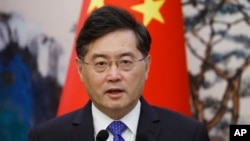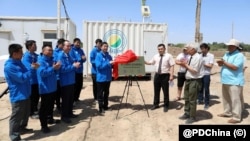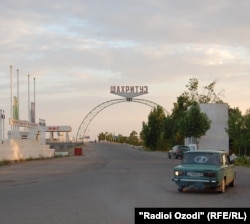
Welcome back to the China In Eurasia briefing, an RFE/RL newsletter tracking China’s resurgent influence from Eastern Europe to Central Asia.
I’ve returned from a short summer hiatus in my native Canada and here’s what I’m following now that I’ve returned to RFE/RL’s newsroom in Prague.
China's Missing Foreign Minister Gets Replaced
Chinese Foreign Minister Qin Gang was suddenly replaced on July 25 by his predecessor Wang Yi in a surprise shake-up to China’s foreign policy leadership.
Finding Perspective: Qin has not been seen in public since late June and the announcement of his removal at a special session of the National People’s Congress Standing Committee came after weeks of speculation about his fate.
Qin has only been on the job for seven months and assumed the role as Chinese leader Xi Jinping’s handpicked successor after serving as China’s ambassador to Washington.
No reason was provided for Qin’s removal, but his mysterious absence has fueled a wide array of rumors about what happened to him.
China’s Foreign Ministry cited unspecified health reasons for Qin’s absence from the Association of Southeast Asian Nations (ASEAN) meeting in Indonesia earlier this month, but has not commented since.
Other rumors have linked his disappearance to an alleged affair with a Chinese state-run TV anchor, a severe case of COVID-19, or that he is under government investigation.
Why It Matters: Like most high-level moves in Beijing, this one exists within China’s black-box political system and his removal raises more questions than answers.
What did Qin do? Is Wang’s appointment long-term? Did Qin lose an internal Party battle? Did his time spent in the United States leave him vulnerable to accusations of being politically compromised by foreign intelligence?
It may be some time -- if ever -- before we get some answers to those questions. But here’s what we do know.
Wang became China’s top diplomat when he joined the Politburo in October and state media reports didn’t mention any change to Wang’s party roles, suggesting he would occupy his Politburo and Foreign Ministry positions at the same time. Some analysts have speculated that this signals that he will be a placeholder until a younger replacement can be found.
Qin appears to maintain his role as state councilor, a senior government rank in the State Council, China’s cabinet, with the State Council’s website continuing to list him as a state councilor. Mentions and images of him on the Foreign Ministry's website, meanwhile, have been removed.
Some have speculated this indicates that Qin is under investigation and that he has been sucked into China’s extrajudicial interrogation system for Communist Party members who are viewed as politically suspect.
Qin has been regarded as a fast-rising protege to Xi, and is said to have been pulled up through the ranks by the Chinese leader. His appointment last year as foreign minister over more experienced candidates caused some surprise among observers of elite Chinese politics.
That close association with Xi makes the episode particularly intriguing, but with few details known about Qin’s disappearance, it’s difficult to figure out how exactly his removal will change things behind the scenes.
Expert Corner: The Ripple Effects From Qin’s Disappearance
Readers asked: “What message does Qin Gang’s absence and removal as foreign minister send to the world and does it hurt Chinese foreign policy?”
To find out more, I asked Sari Arho Havren, an associate fellow at London’s Royal United Services Institute:
“Qin Gang is not the first, and not the last, high-ranking official to go missing in China. The ‘loud’ silence follows the Chinese Communist Party’s pattern of secretive behavior. While he has been removed and now replaced, the longer the absence takes without a sensible explanation, the higher the chances that Qin’s career is finished. From Beijing’s perspective, however, the way Qin’s disappearance radiates to the outside world is a minor, if any, concern at all.
“Qin’s absence is, however, not entirely without consequences abroad. While China is facing a myriad of challenges and is trying to woo foreign investors back, a missing foreign minister does not increase confidence in China’s conditions and stability. Instead, it further underlines the dissonance between the country’s political and business environments.
“Additionally, foreign ministerial level meetings have been postponed or downgraded to the vice-minister level. While Qin’s disappearance caused delays in diplomacy and fueled speculation, the long-term consequences are likely minimal. Once Beijing closes the case, the whole episode will quickly be forgotten as the majority of other countries have gotten used to dealing with the Communist Party’s abnormal behavior.”
Do you have a question about China’s growing footprint in Eurasia? Send it to me at StandishR@rferl.org or reply directly to this e-mail and I’ll get it answered by leading experts and policymakers.
Three More Stories From Eurasia
1. A Chinese 'Super' Observation Station
A new Chinese “super” observation station for climate and environmental monitoring opened in Tajikistan in June, but what’s behind the appearance of the station in Central Asia? I looked into it here.
What You Need To Know: The station -- located in Shahritus, a town in southwestern Tajikistan near the meeting point of the country's borders with Afghanistan and Uzbekistan -- is part of a growing constellation of stations in countries along Beijing’s Belt and Road Initiative (BRI) that are run by or partnered with Lanzhou University.
Scientists from Lanzhou University say the station provides comprehensive data for dust, pollutants, and weather in key areas of Central Asia and that it can help warn about extreme weather conditions, as well as provide data about climate change.
The station uses LiDAR (light, detection, and ranging) systems, which help scientists to accurately map and examine natural and manmade environments.
But as Bradley Jardine, managing director of the Oxus Society for Central Asian Affairs, told me, LiDAR systems are also a key component of smart, autonomous, and electric vehicles -- a sector where China is an emerging global leader -- and the broader network that the new station is part of is designed to allow China to refine its domestic technology.
“As China positions itself to become dominant in the future global automotive industry, there are a large number of state grants available for refining the technology, and research institutes like Lanzhou are on the cutting edge,” Jardine said.
The station’s location and the Tajik government’s close cooperation with Beijing have also raised questions about whether it could be used for surveillance and security purposes, especially given that China has financed, built, and in some cases helped operate surveillance and security outposts and facilities in Tajikistan.
While the station’s full scope is unclear, Jardine noted that stations like those in Shahritus “rely on weather satellites -- possibly similar in nature to the object that had recently run errant across the United States,” in reference to the high-altitude Chinese balloon that traversed Canada and the United States in February and was said by U.S. and Canadian officials to be used for espionage and surveillance.
2. What We Learned From A Virtual SCO
This year’s annual Shanghai Cooperation Organization (SCO) summit was held virtually and wrapped up on July 4 in comparatively muted fashion to last year’s meeting in Uzbekistan.
But what are the key takeaways from one of Eurasia’s main political gatherings?
The Details: Last year’s summit in Uzbekistan was a multiday event that garnered outsized attention around the world because it was the first time that Xi and Russian President Vladimir Putin met in person since Russia’s full-scale invasion of Ukraine. Xi’s trip to Kazakhstan en route to the summit also marked his first foreign trip since the beginning of the COVID-19 pandemic.
The 2022 summit’s high-profile billing led to increased momentum about the SCO becoming the premier bloc for the region and something that could eventually rival Western-led organizations, given that it is spearheaded by China and Russia and its members comprise around 40 percent of the global population.
In comparison, the 2023 gathering hosted by India was virtual, a format believed to be adopted due to concerns in New Delhi over hosting Putin in person and strained relations between India and China.
This tale of the two summits illustrates the contradictions inherent within the SCO.
The grouping continues to extend its reach -- something seen this year with Iran becoming a new member and Belarus slated to join next year -- but the SCO is still hamstrung by a tangled web of interests and allegiances among its members, which includes includes China, Russia, India, Pakistan, Kazakhstan, Kyrgyzstan, Tajikistan, and Uzbekistan.
Kazakhstan has assumed chairmanship of the bloc and the 2024 summit will be held in Astana, where it is likely to receive higher billing from its host government.
Kazakh President Qasym-Zhomart Toqaev has already called for closer cooperation within the SCO on energy and Astana is likely to use its chairmanship to focus on the issue.
3. The Transit Ground
Trade data shows Central Asia’s imports from China are up sharply, with heavy truck shipments from China to Central Asia tripling this year, in another sign of how the region is becoming a growing hub for Chinese dual-use goods reaching the Russian military.
What It Means: A new report by Joseph Webster for the Lowy Research Institute said that most imported goods are then re-exported to Russia.
As Webster notes, such flows have helped Russia stave supply shortages, but also to avoid making tough calls on which manufactured products to prioritize in production. “Importing certain industrial products could allow the Kremlin to repurpose production lines for military goods, such as tanks or armored vehicles,” he wrote.
According to Chinese customs data, Beijing has exported $16.6 billion worth of goods to Central Asia, up 140 percent from the same period in 2021.
The report feeds into a growing body of evidence that Beijing is delivering enough militarily useful -- although non-lethal -- equipment to Russia to have a material impact on the Kremlin’s war on Ukraine.
A new investigation from Politico found that Russian buyers have declared orders for hundreds of thousands of bulletproof vests and helmets made by Shanghai H Win, a private Chinese manufacturer. The shipments, along with those of Chinese-made drones and other products, show the loopholes being used to keep Russia’s war machine afloat amid sanctions.
Across The Supercontinent
Bye-Bye BRICS: South Africa has announced that Putin, who has an outstanding arrest warrant issued in his name by the UN’s International Criminal Court (ICC), will not travel to the BRICS summit in Johannesburg next month.
Partners At Sea: China and Russia wrapped up air and naval exercises in the Sea of Japan on July 23 that the Chinese Defense Ministry said were aimed at “safeguarding” the security of waterways.
Gassed Up: According to Chinese Customs data, Uzbekistan sold nearly $204 million worth of gas to China in this year’s second quarter. This ranks the country as China’s fifth largest source of gas.
Content Control: Sohu, the prolific Chinese website, sparked backlash in Tajikistan after it published an article saying that the Central Asian country of nearly 9.7 million has over 800,000 widows. A claim that was not tied to any source of information or survey.
After Tajik media -- including RFE/RL’s Tajik Service -- reported on the claims and some user comments on Sohu, the article was then removed. No explanation has been provided, but articles regularly vanish from China’s heavily censored Internet and there is precedent for controversial articles about Central Asia being removed after they sparked backlash in the region.
One Thing To Watch
Chinese stocks soared on July 25 as Beijing pledged to ramp up measures to bolster China’s sputtering economy.
The stock rebound comes after China’s top leaders pledged to ramp up policy support to boost domestic consumption as the post-COVID rebound has been slower than expected for the Chinese economy.
Xi’s hold on power rests on the belief that he drives prosperity for his people. Yet economic growth has been -- in relative terms for China -- muted, and local government debt remains problematic.
Last week, official data showed that economic recovery in China continued to lose momentum in the April to June months, prompting urgent calls for more help from the central government.
That’s all from me for now. Don’t forget to send me any questions, comments, or tips that you might have.
Until next time,
Reid Standish
If you enjoyed this briefing and don't want to miss the next edition, subscribe here. It will be sent to your inbox every other Wednesday.







